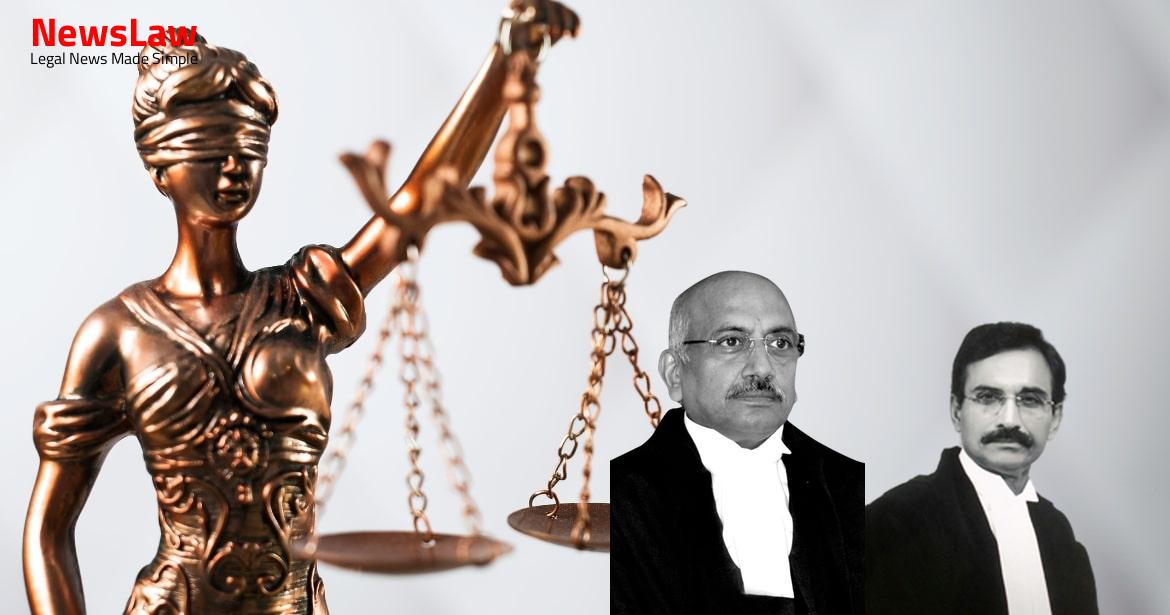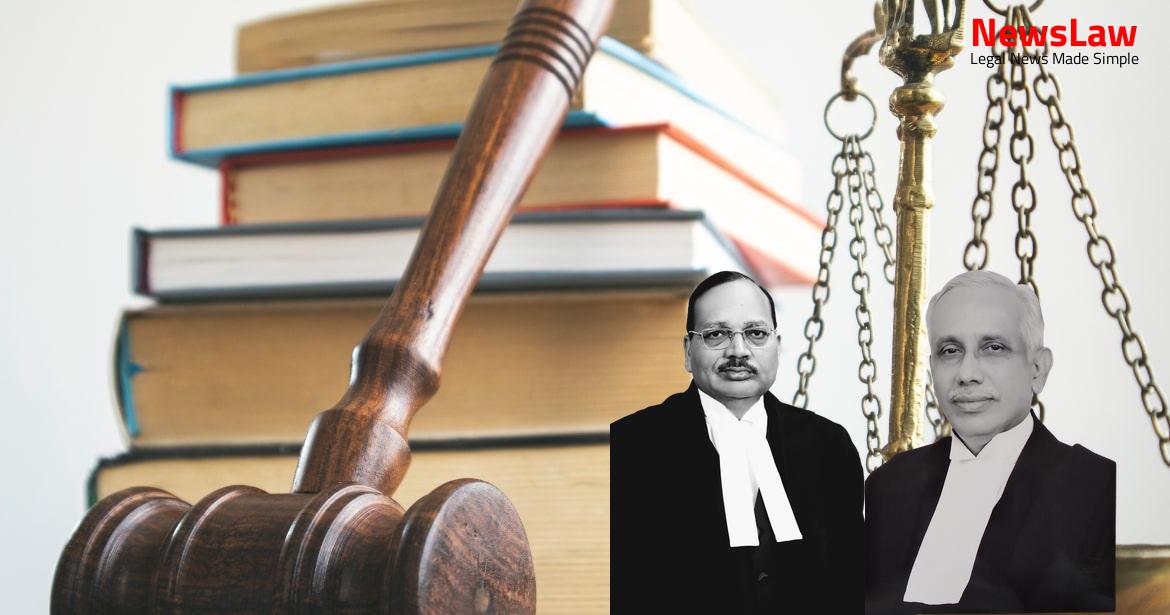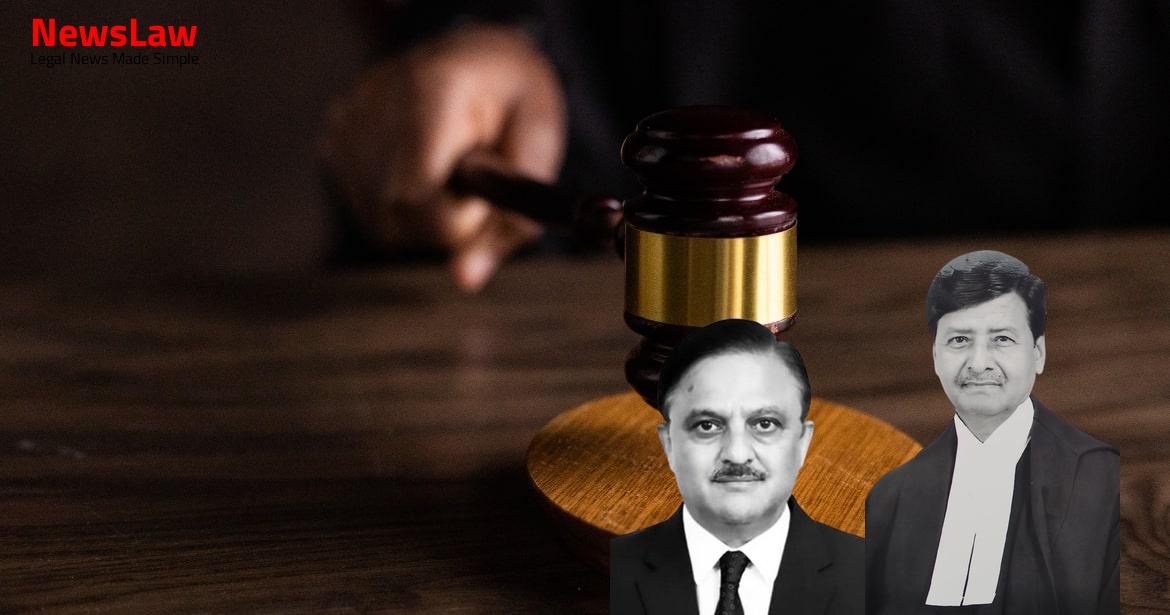In a recent landmark judgment, the Supreme Court of India upheld the conviction in the case involving the appellants and the deceased, where circumstantial evidence played a crucial role. The court emphasized the significance of witness testimonies, motive, and the chain of events leading to the conclusion of guilt. This ruling sheds light on the legal intricacies surrounding cases of this nature, setting a precedent for future proceedings.
Facts
- The prosecution presented Bhupinder Singh (PW-16) as a witness for extra-judicial confession.
- FIR copy was sent to the concerned Magistrate.
- Harpal Singh (PW-11) Sarpanch’s statement indicated Surjit Kaur’s complaint about non-payment of lease money by her son Avtar Singh.
- On 29th March 2005, a telephone diary was found in the inner pocket of the dead body’s undershirt, along with telephone numbers of some individuals.
- Recovery of a TVS Motor Cycle and folding iron chair from disclosed locations.
- Swaran Kaur admitted to taking ½ a bottle of acid and Dr. Harbhajan Singh stated the cause of death as poisoning due to Aluminum Phosphide Insecticide and other factors.
- Accused Avtar Singh, Jagmohan Singh, Swaran Kaur, and Darshan Singh were put on trial after completion of investigations and witness statements under Section 161 of the Criminal Procedure Code, 1973.
- Primary witness Kuldeep Singh (PW-13) alleged the murder of Surjit Kaur by Avtar Singh, Swaran Kaur, Jagmohan Singh, and Darshan Singh.
- Investigating officer Balwant Singh (PW-15) testified on various findings and recoveries including the dead body, diary, and statements of witnesses.
- Accused Jagmohan Singh, Swaran Kaur, and Darshan Singh were convicted while Avtar Singh was acquitted by the learned Sessions Judge.
- The death of Surjit Kaur was reported in newspapers and investigations revealed various details including motives for the murder.
- Bhupinder Singh (PW-16) and Kuldeep Singh (PW-13) statements were relied upon by the trial court to convict Jagmohan Singh, Swaran Kaur, and Darshan Singh.
- Sukhdev Singh’s (PW-14) testimony was not considered reliable by the trial court due to his inability to establish the identity of the accused in court.
- The testimony of Kuldeep Singh (PW-13) was unchallenged, indicating that deceased Swaran Kaur was living alone in a room and not with her son Avtar Singh and his family, suggesting strained relations with her son and daughter-in-law.
Also Read: High Court’s Ruling on Quashing of Proceedings in the Case of Sri K. Sampath Kumar
Arguments
- The appellants were convicted based on the recovery of poison, which led to the conclusion that they were the perpetrators.
- The evidence of ‘last seen’ was not considered credible by the trial court.
- The conviction relied on extra-judicial confession as a significant piece of evidence.
- The High Court upheld the convictions based on statements of key witnesses (PW-13 and PW-16) and established motive (PW-11).
- The defense argued that the prosecution failed to establish a complete chain of events to prove guilt.
- Citing previous judgments, it was emphasized that extra-judicial confession may lead to conviction if the person recording the confession is unbiased.
- No motive could be attributed to the accused as the deceased was last seen by PW-13 on a specific date, contradicting the established timeline of events.
- The witness PW-13, who met the deceased before her death, was highlighted as key to explaining the circumstances of her demise.
- Questions were raised about the deceased’s location and the credibility of findings due to inconsistency in evidence.
- The postmortem report indicated poisoning as the cause of death, but lacked evidence on the method of administration of the poison.
- Sharad Birdhichand Sarda v. State of Maharashtra and Devi Lal v. State of Rajasthan were cited to show how circumstantial evidence can lead to conviction.
- The evidence of last seen was not accepted, but Sukhdev Singh (PW-14) mentioned seeing a man and woman on a TVS Motorcycle, relevant to the case.
- Harpal Singh (PW-11), the Sarpanch, testified about the motive involving property inheritance leading to conflict.
- Kuldeep Singh (PW-13) spoke about the deceased living separately, inheritance of land, and lease details, also mentioning the deceased’s previous marriages and family.
- Ujjagar Singh identified the dead body of the deceased at the Police Station.
- Balwant Singh (PW-15), the Investigating Officer, discovered the dead body of the woman in a gunny bag.
- Reference to the judgment in Ram Lal v. State of Himachal Pradesh was made regarding the need for corroboration in cases of extra judicial confession.
- Various details regarding the investigation, cremation, and specific events surrounding March 20, 2005 were presented during the proceedings.
Also Read: Equivalency of Educational Qualifications in the Case of Instructors’ Appointments
Analysis
- The deceased had visited Darshan Singh’s house 25 days prior to the occurrence.
- Darshan Singh never telephoned the deceased between her visit and their meeting on 20 March, 2005.
- Darshan Singh conducted raids to arrest accused named by witnesses but they were not found.
- Darshan Singh was convicted based on an extra-judicial confession where he admitted to hitting the deceased.
- The postmortem report showed fractures and wounds consistent with the confession.
- The deceased was living separately and not receiving lease money necessary for survival.
- Accused were not found in the village soon after the occurrence.
- The body was disfigured with acid, possibly to avoid identification.
- The jute bag thrown by a man and a woman on a TVS motorcycle is relevant in the chain of events.
- No ligature mark was found due to maggot infection on the body.
- Recovery of acid bottle based on disclosure by Swaran Kaur is a significant piece of evidence.
- The witness of last seen identified the manner in which the jute bag was discarded despite not recognizing the appellants.
- Gurmit Singh, another son of the deceased, passed away in 2003.
- Darshan Singh disclosed hiding a folding iron chair in Avtar Singh’s house which was later found
- The prosecution successfully proved the chain of circumstances leading to the guilt of the appellants
- Based on the evidence and findings of the lower courts, the appeals were dismissed
Also Read: Interpretation of Mandatory Statutory Time Limits
Decision
- Darshan Singh and Jagmohan Singh shall surrender to undergo the remaining sentence.
- Appellant No.2, Swaran Kaur, has passed away during the appeal process.
Case Title: DARSHAN SINGH Vs. STATE OF PUNJAB
Case Number: Crl.A. No.-001688-001688 / 2009



